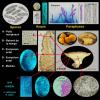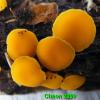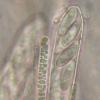
02-01-2026 17:43
MARICEL PATINOHi there, although I couldn't see the fruitbody, I

04-01-2026 17:45
 Stephen Martin Mifsud
Stephen Martin Mifsud
I was happy to find these orange asmocyetes which

03-01-2026 13:08
Niek SchrierHi all,We found groups of perithecia on a Lecanora

29-12-2025 17:44
Isabelle CharissouBonjour,J'aimerais savoir si d'autres personnes au

01-01-2026 18:35
Original loamy soil aside a artificial lake.The co

31-12-2025 19:27
Collected from loamy soil, at waterside (completel
50239 - Hymensocyphus sp. ?
Roland Labbé,
07-04-2010 02:47
Voici un disco qui nous est inconnu, peut être un Hymenoscyphus ?
Merci de bien vouloir nous aider.
Amitiés !
Roland
Détails :
Date de récolte : 22 / 08 / 2009
Habitat : forêt mixte
Substrat : débris ligneux d'érable très décomposé
Sporée non disponible
Marge d'aspect enroulé
Pied large, un peu plus étroit à la base
Spores cylindriques-fusoïdes, lisses, à 1 septum médian, rarement à 2-3 septa, guttulées, hyalines en NaCl iso., bourgeonnant assez souvent aux extrémités et / ou sur les côtés, 10-17 x 3,5-4,5 µm, 14,2 x 3,5 µm en moyenne (10 spores), Q = 3,46
Asques à 8 spores unisériées, avec appareil apical faiblement amyloïde et crochet à la base, 88-105 x 7-8 µm
Paraphyses cylindriques, rarement ramifiées à la base, parfois un peu élargies ou recourbées à l'apex, septées, à contenu huileux à 70-100%, de longueur très inégale, dépassant ou non les asques de 5-15 µm, mesurant 70-105 x 1,5-2,5 µm
Poils marginaux intérieurs cylindriques, en palissade, 2-3 µm de diam.
Partie recourbée de la marge formée de cellules globuleuses, ellipsoïdes, cylindriques, parfois en chaîne, avec terminaison clavée à fusoïde obtuse, où les spores semblent s'agglutiner en abondance
Poils de l'excipulum dispersés, cylindriques, un peu élargis à base
Excipulum ectal en textura globulosa à globulosa-angularis
Excipulum ental en textura prismatica
Roland Labbé,
07-04-2010 15:25
MORA JOSE,
07-04-2010 15:48
Re:50239 - Hymensocyphus sp. ?
¿Il peut être Hymenoscyphus.calyculus (Sowerby) W. Phillips?
Hans-Otto Baral,
07-04-2010 16:37

Re:50239 - Hymensocyphus sp. ?
I also considered calyculus, but the short stalk and the partly homopolar spores, also the globose cells on the lower flanks indicate for H. epiphyllus or H. monticola. In the dead state I feel unable to distinguish the two, although the bright yellow colour would be more typical for H. monticola (= Phaeohelotium monticola).
Zotto
Zotto
Roland Labbé,
07-04-2010 17:02
Re:50239 - Hymensocyphus sp. ?
Zotto, according to you, what is the good genus now, Hymenoscyphus or Phaeohelotium for monticola ?
Roland
Roland
Hans-Otto Baral,
07-04-2010 18:32

Re:50239 - Hymensocyphus sp. ?
I have no clear opinion. Genetics tell for two groups, but not enough species are sequenced so far. And position of Cudoniella is still not clear. Genus concepts are tro some degree a matter of taste. I tend to a less splitting which results in some cases in rather big genera.
So you can use both, as you wish.
Zotto
So you can use both, as you wish.
Zotto
Bernard Declercq,
07-04-2010 20:46

Re:50239 - Hymensocyphus sp. ?
Could this be "Hymenoscyphus" lutescens? I never have seen such species before. Anyhow, this is species belongs to my Phaeohelotium concept, so that, as already said, H. calyculus should be excluded.
Bernard
Bernard
Hans-Otto Baral,
07-04-2010 21:24

Re:50239 - Hymensocyphus sp. ?
Hi Bernard
H. lutescens is actually close to H. epiphyllus, but it is a species confined to rather unrotten conifer debris, especially cones. I have here a photo of the paraphyses with strongly refractive multiguttulate contents (VBs), which are also typical of H. epiphyllus, but never seen in H. monticola. So it would depend on seeing living paraphyses of Roland's collection (to be re-collected).
Zotto
H. lutescens is actually close to H. epiphyllus, but it is a species confined to rather unrotten conifer debris, especially cones. I have here a photo of the paraphyses with strongly refractive multiguttulate contents (VBs), which are also typical of H. epiphyllus, but never seen in H. monticola. So it would depend on seeing living paraphyses of Roland's collection (to be re-collected).
Zotto
Roland Labbé,
08-04-2010 01:24
Re:50239 - Hymensocyphus sp. ?
Zotto, since P. monticola is a rather recent species, do you have a key
or a document to study it more ?
I would like to compare the data of our species with those close.
Roland
or a document to study it more ?
I would like to compare the data of our species with those close.
Roland
Roland Labbé,
08-04-2010 01:24
Re:50239 - Hymensocyphus sp. ?
Zotto, since P. monticola is a rather recent species, do you have a key
or a document to study it more ?
I would like to compare the data of our species with those close.
Roland
or a document to study it more ?
I would like to compare the data of our species with those close.
Roland
Roland Labbé,
08-04-2010 01:24
Re:50239 - Hymensocyphus sp. ?
Zotto, since I think P. monticola is a rather recent species, do you have a key
or a document to study it more ?
I would like to compare the data of our species with its relatives.
Roland
or a document to study it more ?
I would like to compare the data of our species with its relatives.
Roland
Hans-Otto Baral,
08-04-2010 20:07

Re:50239 - Hymensocyphus sp. ?
You don't have the DVD? You will find images there, I am sure. The species is not recent, it was described by Kanouse around 1940, and is the type of Phaeohelotium.
Zotto
Zotto





